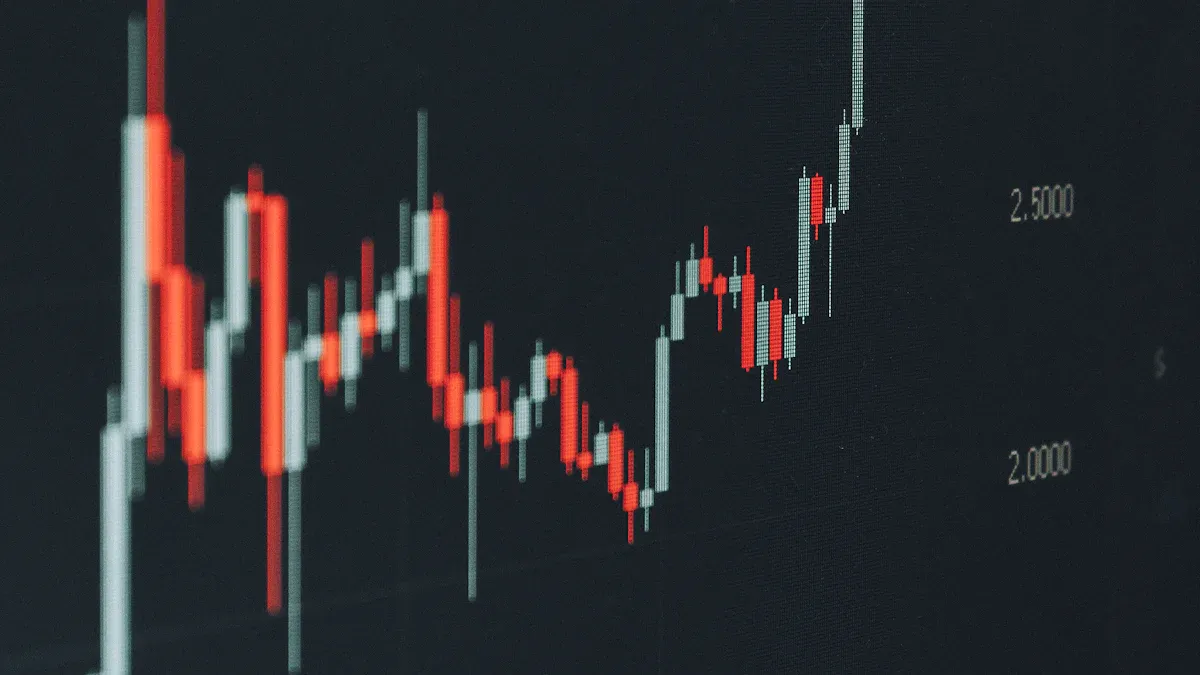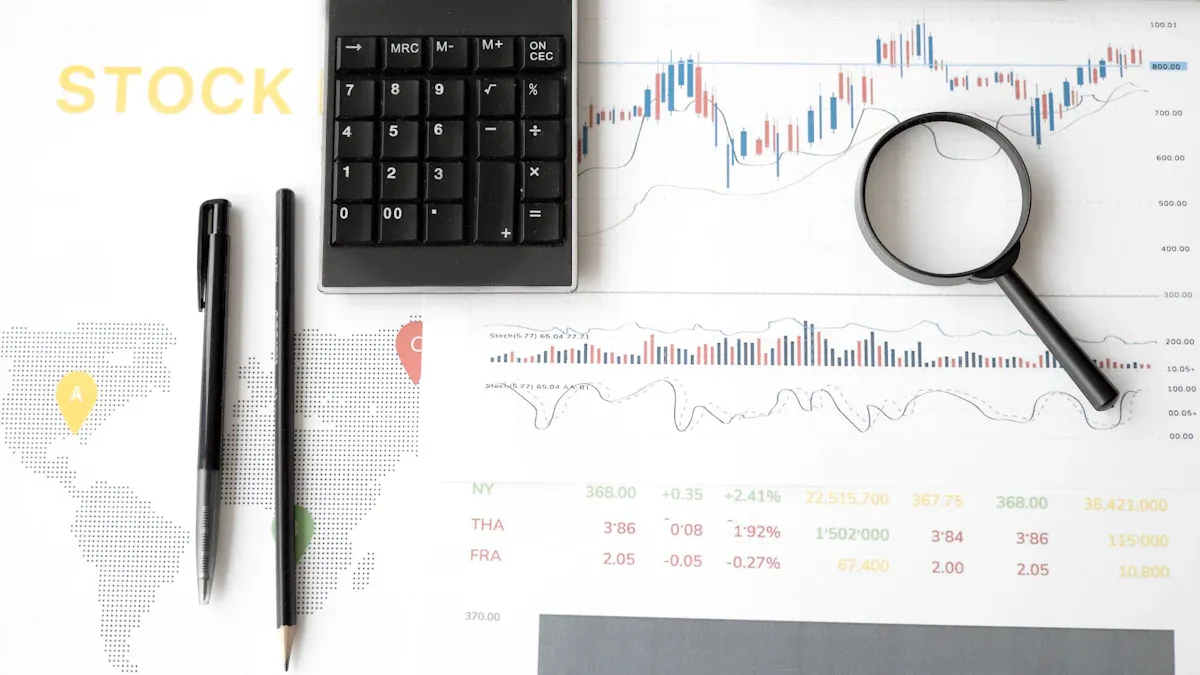- EasyCard
- Trade
- Help
- Announcement
- Academy
- SWIFT Code
- Iban Number
- Referral
- Customer Service
- Blog
- Creator
How Stock Prices Are Determined: Understanding the Price Formation Mechanism Behind the Market

Image Source: pexels
The determination of stock prices primarily relies on the supply and demand relationship and matching mechanisms in the market. Buyers aim to purchase at lower prices, while sellers hope to sell at higher prices. Prices are constantly adjusted in their interactions. The Dow Theory posits that market prices already reflect all known information.
- Changes in trading volume directly affect the price formation process.
- Large-scale transactions by institutional investors often lead to price fluctuations.
- When supply and demand are imbalanced, prices change rapidly.
Many investors mistakenly believe that performance is the sole factor affecting stock prices, but in reality, market structure, trading volume, and investor behavior are equally important.
Key Points
- Stock prices are determined by supply and demand. When there are more buyers, prices rise; when there are more sellers, prices fall.
- Market matching mechanisms enhance trading efficiency. Modern exchanges use order book systems to quickly match buy and sell orders.
- The Dow Theory emphasizes that market prices reflect all known information. Understanding price trends aids investment decisions.
- Company fundamentals, macroeconomic factors, and market sentiment collectively influence stock prices. Investors should consider multiple factors.
- Rational analysis and risk control are key to successful investing. Diversified investments and long-term holding can reduce risks.
How Stock Prices Are Determined

Image Source: pexels
Supply and Demand
The determination of stock prices is primarily reflected in the supply and demand relationship. In the market, the forces of buyers and sellers directly influence prices. When the number of buyers exceeds sellers, prices rise; conversely, when sellers outnumber buyers, prices fall.
- Company performance, economic indicators, and market sentiment collectively influence supply and demand. For example, excellent earnings reports increase investors’ willingness to buy, pushing prices upward.
- Institutional investors play a significant role in supply and demand dynamics. Their trading volume typically accounts for 70% to 90% of daily transactions, with single trades often exceeding 10,000 shares. Rational decisions by institutional investors help stabilize prices, but in extreme market conditions, emotional trading by retail investors can amplify volatility.
- During the COVID-19 pandemic and the 2008-09 financial crisis, retail trading activity significantly increased market volatility, with volatility levels about 30% higher than usual. These cases demonstrate that the behavior of buyers and sellers has a more pronounced impact on stock price determination during special periods.
Supply and demand are influenced not only by company fundamentals but also by macroeconomic factors and market psychology. Investors should focus on multiple factors to understand the logic behind price changes.
Market Matching Mechanism
The market matching mechanism is an indispensable part of stock price determination. Modern exchanges use order book systems to automatically match buy and sell orders. Technological advancements have greatly improved matching efficiency and accuracy.
- High-frequency trading and algorithmic trading enable near-instantaneous order matching, enhancing market liquidity and reducing transaction costs.
- Advanced algorithms (such as FIFO and Pro Rata) optimize the fairness of order execution. Artificial intelligence and machine learning further enhance the intelligence level of order matching.
- The practical application of the order book mechanism is shown in the table below:
| Evidence Content | Description |
|---|---|
| Realistic order book mechanisms are integrated into artificial stock markets | Used to analyze price dynamics. |
| Compared two market scenarios | One with daily price margins (similar to BIST) and one without (similar to NASDAQ). |
| Risk-aware fundamental traders exhibit herd behavior | Influences market price trends. |
| Presence of daily price margins | Stabilizes stock prices, reduces volatility, and benefits fundamental traders. |
| Spontaneously emerging sinusoidal price patterns | Driven by the interaction of trader strategies and dynamic risk levels. |
- Regulatory policies also significantly impact the transparency and efficiency of matching mechanisms. Moderate pre- and post-trade transparency enhances market effectiveness, but excessive transparency may reduce market participation and increase volatility. Historical data shows that increasing securities transaction taxes widens bid-ask spreads, reducing trading volume and affecting price stability.
Dow Theory
The Dow Theory provides a theoretical foundation for stock price determination. It posits that market prices reflect all known information, and price movements follow certain patterns.
- The Dow Theory categorizes price trends into primary trends, secondary trends, and minor trends. Primary trends last the longest, typically over a year, determining the market’s overall direction. Secondary trends reflect short-term fluctuations, lasting weeks to months. Minor trends are considered market noise.
- Trend formation consists of accumulation, public participation, and distribution phases. Informed investors build positions during the accumulation phase, followed by more investors joining, driving trend development. At the trend’s end, initial investors gradually exit.
- The Dow Theory emphasizes that trends are confirmed only when major indices (such as the Dow Jones Industrial Average and Dow Jones Transportation Average) move in the same direction. Changes in trading volume also validate trend strength. The table below summarizes the core components of the Dow Theory:
| Trend Type | Feature Description |
|---|---|
| Primary Trend | Lasts over a year, typically the market’s main direction. |
| Secondary Trend | Market corrections, lasting weeks to months, reflecting short-term fluctuations. |
| Minor Trend | Considered insignificant noise by some, typically minor market fluctuations. |
| Accumulation Phase | Informed investors start buying or selling under prevailing sentiment. |
| Public Participation Phase | Broader market participation in the trend as it becomes more apparent. |
| Distribution Phase | Initial investors begin exiting positions as public enthusiasm peaks. |
| Index Comparison | A trend is valid only when the Dow Jones Industrial Average (DJIA) and Dow Jones Transportation Average (DJTA) move in the same direction. |
| Trading Volume | Should increase in the direction of the primary trend, confirming the strength of price movements. |
| Trend Confirmation | Trends remain valid until a clear reversal signal appears, avoiding premature conclusions based on minor fluctuations or temporary pullbacks. |
The Dow Theory reminds investors that market prices reflect not only company fundamentals but also economic conditions, market sentiment, and investor behavior. Understanding these trends helps investors better grasp how stock prices are determined.
Influencing Factors
Company Fundamentals
Company fundamentals are a key factor in stock price determination. A company’s profitability, balance sheet, and cash flow directly influence investor judgments. Research shows a significant positive correlation between stock prices and company fundamentals, particularly during unexpected events, when market prices often deviate from intrinsic value before reverting.
- There is a significant positive correlation between stock prices and company fundamentals.
- Before the financial crisis, market prices were less influenced by fundamentals.
- Recently, market prices have risen significantly while fundamentals have deteriorated.
| Evidence Type | Result Description |
|---|---|
| Empirical Studies | Company fundamentals explain approximately 30% of cross-sectional stock price variability. |
| Portfolio Performance | Long-short portfolios provide about 19% annual returns with annualized volatility below 7%. |
| Market Efficiency | Market prices generally converge with fundamentals but may significantly deviate in the short term. |
Macroeconomic Factors
The macroeconomic environment has a profound impact on stock price determination. Indicators such as GDP growth, interest rate changes, and consumer spending influence market expectations.
GDP typically moves in sync with the stock market. Any divergence between the two is temporary, and in the long run, the stock market and GDP generally move in the same direction, reflecting the economy’s current state. (Marisha Bhatt, 2023)
| Indicator | Impact |
|---|---|
| GDP Growth | Typically leads to increased stock market returns. |
| Rising Interest Rates | Leads to stock price declines due to higher borrowing costs. |
- Consumer spending and corporate capital expenditure remain strong, which is a reason for bullish stock market outlooks. (Eric Freedman)
Market Sentiment
Market sentiment significantly influences short-term stock price fluctuations. Investors’ fear, greed, and herd mentality often cause prices to deviate from fundamentals. Behavioral finance reveals that people are not always rational, and investor decisions are influenced by various psychological factors.
- Behavioral finance combines psychology and economics to explain why investors often make irrational financial decisions.
- Factors such as fear, greed, overconfidence, and herd mentality influence investment decisions.
- This field emphasizes the importance of human behavior in investment decisions, often overlooked by algorithms and economic theories.
| Study | Findings |
|---|---|
| Effects of investor sentiment on stock volatility | Investor sentiment significantly affects short-term stock market volatility, especially during heightened uncertainty. |
| Dual effects of investor sentiment and uncertainty in financial markets | Investor sentiment has a more pronounced impact on short-term stock market returns when uncertainty increases. |
Industry and Global Factors
Industry trends and global events also influence stock price determination. The U.S. market often experiences price fluctuations during presidential elections as investors speculate on new government economic policies. Global financial crises, geopolitical conflicts, and pandemics can lead to significant market volatility.
- Political events (such as elections, coups, and policy changes) cause market fluctuations.
- Economic indicators (such as GDP growth rates, unemployment rates, and inflation statistics) play a key role in setting market expectations.
- Global financial crises typically lead to market panic and rapid sell-offs.
- Geopolitical events (such as wars, trade disputes, and territorial conflicts) also significantly impact the stock market.
| Study | Key Findings |
|---|---|
| Pandemic, policy, and markets | During the early stages of the pandemic, market volatility significantly increased, with overall volatility in 2020 higher than pre-pandemic levels. |
| Unleashing the pandemic volatility | Stock markets exhibited negative returns and increased volatility during COVID-19, showing volatility clustering. |
- During COVID-19, all stock indices recorded negative returns, compared to positive returns before the pandemic.
- Volatility clustering and leverage effects were observed, indicating the market’s sensitivity to crises.
Volatility Scenarios

Image Source: pexels
Short-Term Volatility
Short-term volatility is the most common phenomenon in the stock market. Prices fluctuate frequently within short periods, and investors often feel market uncertainty. Researchers have found that asymmetric GARCH and EGARCH models can more accurately capture the characteristics of short-term volatility.
- EGARCH models perform excellently in predicting market volatility, especially at the start and end of high-volatility periods.
- Stock market returns show persistent volatility with leverage effects.
- Macroeconomic uncertainty significantly impacts U.S. stock market volatility and price jumps, surpassing traditional indicators like VIX.
Market analysts typically use regression analysis, moving averages, and time-series analysis to predict short-term price changes. These models help investors identify abnormal market fluctuations and adjust strategies promptly.
Long-Term Trends
Long-term trends reflect market changes with economic cycles. Historical data shows that the stock market experiences alternating bull and bear markets. In bull markets, each high is higher than the previous one, boosting market confidence. Bear markets show progressively lower highs, with investor sentiment becoming cautious.
| Market Type | Definition |
|---|---|
| Bull Market | A market trend where each subsequent high is higher than the previous high. |
| Bear Market | A declining market trend that fails to surpass the previous high. |
| Economic Cycle Impact | The stock market typically experiences cycles of high and low returns, reflecting changes in economic conditions. |
Investors can use tools like moving averages and time-series analysis to identify long-term trends. In recent years, enhanced LSTM neural networks combined with symbolic genetic programming have significantly improved the accuracy of stock return predictions, providing a scientific basis for long-term investment decisions.
Nature of Volatility
Volatility is an inherent characteristic of the stock market. Investor sentiment, market structure, and behavioral biases collectively drive continuous price changes.
- Investor sentiment directly affects market volatility.
- Stock market volatility exhibits clear time-varying characteristics.
- Behavioral finance highlights the impact of cognitive biases on investment decisions.
- Emerging markets experience higher volatility due to structural and behavioral differences.
Market volatility is not only a manifestation of risk but also a key indicator of efficient market operation. Understanding the nature of volatility helps investors view price changes rationally and develop more scientific investment strategies.
Investor Strategies
Rational Analysis
Rational analysis is crucial when facing market volatility. Investors typically use multiple methods to evaluate stock price changes.
- Fundamental Analysis: Investors assess a company’s market position and future development through book value, industry data, and economic conditions.
- Technical Analysis: Using price and trading volume data to identify trends and patterns, suitable for short-term trading.
- Qualitative Analysis: Focusing on management teams, product innovation, and industry trends.
- Quantitative Analysis: Using statistical models to predict future price movements.
Combining fundamental and technical analysis enables investors to uncover potential value information. Relying on a single method may miss critical insights. U.S. market history shows that rational analysis helps investors make more robust decisions during major events. For example, during the 2018-2019 U.S.-China trade war, some investors successfully mitigated short-term volatility risks by analyzing policy impacts and industry trends.
Risk Control
Effective risk control strategies can help investors minimize losses during market downturns.
- Diversification: Spreading capital across different asset classes, industries, and regions to reduce the impact of single-market fluctuations.
- Hedging: Using financial instruments like derivatives to offset potential losses.
- Stress Testing: Simulating extreme market scenarios to assess portfolio resilience.
- Risk Budgeting: Allocating risk limits to different investment segments to ensure controllable risk exposure.
- Liquidity Management: Maintaining sufficient cash to avoid forced asset sales at unfavorable prices.
- Continuous Monitoring and Rebalancing: Regularly adjusting portfolios to maintain target risk levels.
Institutional investors typically adopt more systematic risk management processes, while retail investors focus on flexibility. The table below highlights the main differences:
| Aspect | Retail Investors | Institutional Investors |
|---|---|---|
| Risk Tolerance | Lower | Higher |
| Decision-Making Process | Quick and flexible | Structured with strict approvals |
| Market Impact | Minimal | Influences market prices |
| Access to Trading Opportunities | Mainly public channels | Exclusive, large-scale opportunities |
Long-Term Investment
Long-term investment strategies emphasize sustainability and stability. By holding high-quality assets, investors reduce volatility risks from frequent trading.
- Long-term investing focuses on company reliability and industry prospects, minimizing the impact of short-term market fluctuations.
- Historical data from the U.S. S&P 500 index shows that long-term stock holding yields an average annual return exceeding 10%, far surpassing short-term trading.
- Short-term trading carries higher risks and volatility, making consistent profits challenging for retail investors.
Market history proves that adhering to long-term investment principles during significant volatility often yields better returns. For example, during the Smoot-Hawley Tariff Act and U.S.-Japan trade war, some investors successfully navigated intense market fluctuations through diversification and long-term holding.
Stock price determination relies on supply and demand, market matching mechanisms, and information reflection. Rational analysis and risk control are critical in investing. By adopting evidence-based strategies, investors can make more robust decisions during market volatility.
| Evidence Source | Key Point |
|---|---|
| Cogent Strategic Wealth | Emphasizes that evidence-based investment strategies help make sound investment decisions, especially during changing economic or market conditions. |
- Over the past 20 years, only 19% of U.S. stock mutual funds and 11% of fixed-income funds have survived and outperformed their benchmarks.
Evidence-based investment approaches require rigorous academic data to ensure reliable results. Investors should continuously learn about market mechanisms, enhance their understanding, and avoid emotional decisions.
FAQ
Why do stock prices fluctuate dramatically in the short term?
Market news, macroeconomic data, or large institutional trades can lead to rapid price changes. Investor sentiment also amplifies volatility. The U.S. market often sees such phenomena during major news releases.
Will stock prices always fall when a company performs poorly?
Company performance affects stock prices, but market expectations, industry trends, and global events are equally important. U.S. market data shows that some companies with declining performance still see stock price increases due to favorable industry conditions.
How can investors determine if a stock is overvalued?
Analysts typically use metrics like price-to-earnings and price-to-book ratios to assess valuation. In the U.S. market, these methods are commonly combined with industry averages to evaluate whether stock prices are reasonable.
How do market matching mechanisms affect investors?
Matching mechanisms enhance trading efficiency and ensure fairness. U.S. exchanges use advanced algorithms, allowing investors to trade closer to market prices and reducing bid-ask spreads.
Do industry and global events affect all stocks?
Industry and global events have a broad impact, but the extent varies depending on a company’s business. During the pandemic, U.S. tech stocks outperformed traditional sectors, showing differential impacts.
You have now mastered the complex logic behind stock price determination, recognizing that rational analysis and efficient execution are key to investment success. When market supply and demand are volatile and prices fluctuate sharply, your ability to move capital at low cost and high efficiency directly dictates whether you can capitalize on pricing imbalances.
Traditional cross-border fund management and trading models often cause you to miss optimal entry or exit points due to high fees and delayed transfers. You need a platform that supports rational global analysis and high-efficiency US stock execution.
BiyaPay is your high-efficiency investment partner. We offer real-time exchange rate inquiry and conversion for fiat currencies, with remittance fees as low as 0.5%, and zero commission for contract limit orders, helping you allocate every dollar to the investment itself, rather than transaction costs. BiyaPay supports the conversion between various fiat and cryptocurrencies, enabling you to participate in global market trading, including Stocks, all within one platform. There is no need for a complex overseas account, and you can enjoy same-day remittance and arrival. Click the Real-time Exchange Rate Inquiry now, BiyaPay for quick registration, and use peak capital efficiency to turn your rational analysis into tangible returns!
*This article is provided for general information purposes and does not constitute legal, tax or other professional advice from BiyaPay or its subsidiaries and its affiliates, and it is not intended as a substitute for obtaining advice from a financial advisor or any other professional.
We make no representations, warranties or warranties, express or implied, as to the accuracy, completeness or timeliness of the contents of this publication.




Contact Us
Company and Team
BiyaPay Products
Customer Services
is a broker-dealer registered with the U.S. Securities and Exchange Commission (SEC) (No.: 802-127417), member of the Financial Industry Regulatory Authority (FINRA) (CRD: 325027), member of the Securities Investor Protection Corporation (SIPC), and regulated by FINRA and SEC.
registered with the US Financial Crimes Enforcement Network (FinCEN), as a Money Services Business (MSB), registration number: 31000218637349, and regulated by FinCEN.
registered as Financial Service Provider (FSP number: FSP1007221) in New Zealand, and is a member of the Financial Dispute Resolution Scheme, a New Zealand independent dispute resolution service provider.



















